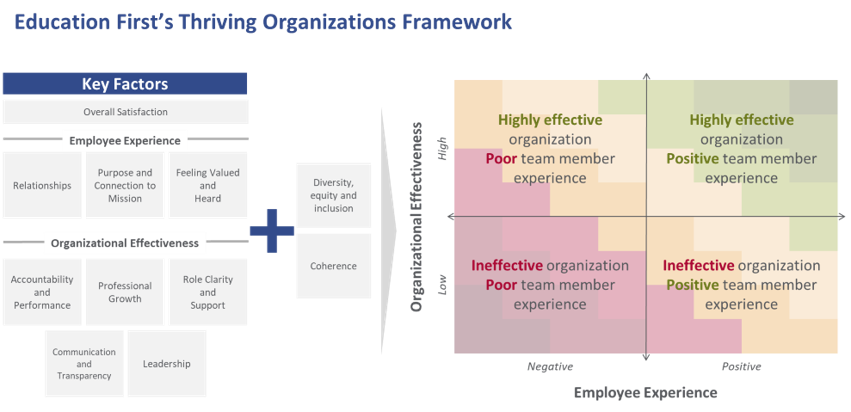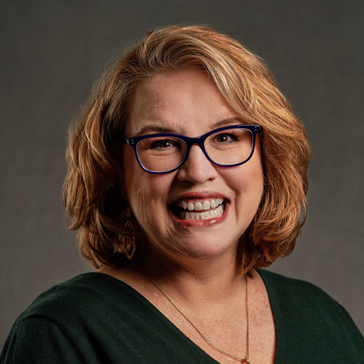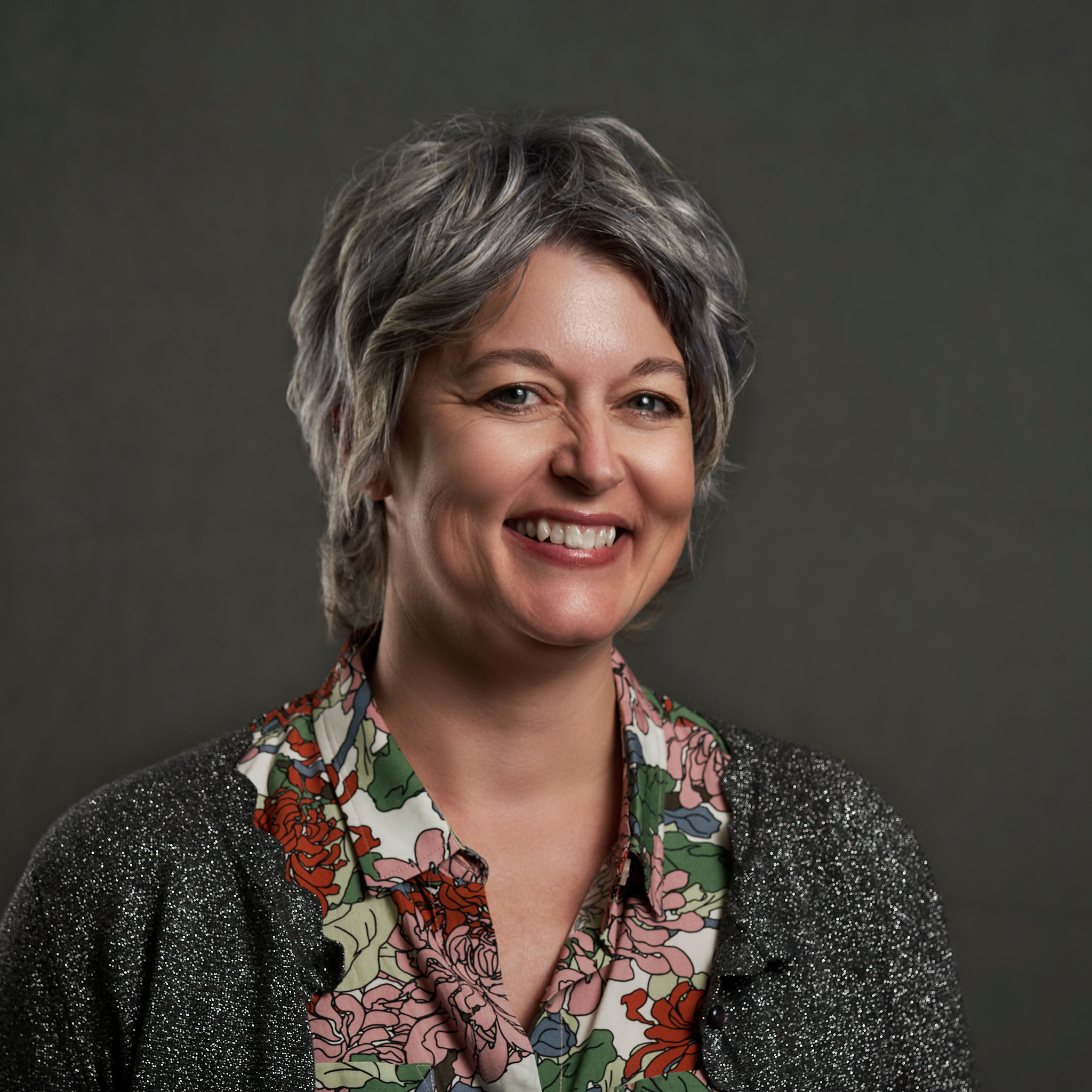
An education-focused organization best achieves its mission and creates desired impact when every team member is connected, engaged and performing at the top of their game to get breakthrough results and make a positive difference for kids. The health of an organization—its ability to thrive—lies at the intersection of the employee experience and organizational effectiveness. This determines who decides to join the team and who decides to stay; how they behave and perform as individuals and teams; and the impact you can have together as an organization.
But one organization alone cannot realize the vision of preparing all students for college, career and life. That is why Education First is helping education leaders across the country create the conditions for their organizations and team members to thrive and have a long-term impact. This is why we developed the Thriving Organizations Profile Survey (TOP Survey), a diagnostic tool to help shine a light on organizational strengths and weaknesses for our clients—and for our own use at Ed First.
Organizational leaders understand that they can create and invest in a thriving organization—including a serious focus on diversity, equity and inclusion—but they don’t always know how to get there.
Amanda Perkins served as Education First’s inaugural Director of Human Capital from 2013-2018, and during that time she helped us to build the foundations of Ed First’s people and culture systems. Not a small feat for an organization that has been entirely virtual since 2006. During that time, she had several leaders from our client organizations reach out, saying “My culture isn’t quite where it could be, and I’m not sure what to do about it. Can you help me fix it?” She realized we needed a diagnostic because culture is influenced by so many things—communication from leadership; whether team members feel valued, heard and connected; the mission of the organization; whether roles are clear; whether team members feel they are growing in their practice, on and on. Ed First invested in research on organizational effectiveness and staff fulfillment to develop the TOP Survey.
At Ed First, we are learning a lot about education organizations from the TOP Survey.
Since October 2019, we have worked with 15 organizations (in education-focused nonprofits, state and county departments of education, one high school, a technology company and our own organization) in administering the TOP Survey. The questions in our survey map back to concepts like employee fulfillment, belonging and psychological safety (e.g., our organization’s culture values differences among individuals; at my organization everyone is encouraged to share dissenting opinions). We found some clear trends and some surprising insights:
But the results are nuanced: disaggregated data helps us understand how staff are experiencing the organization along lines of difference (e.g., tenure, gender, department, LGBTQIA+ status, race, whether one identifies as a person of color). While we often find some groups are having a less positive experience than others, it does vary by organization. For example, in one client organization, tenure is the real difference maker. In another it’s role type. There is no consistent theme across all organizations; but the one that comes closest is whether one identifies as a person of color. Across almost every organization the TOP survey results indicated instances in which staff of color overall were having a less positive experience than their white colleagues, and when that was the case it was evident in more than one index.
Though we repeatedly ensure confidentiality in the survey, in many organizations we have seen a large group that has selected “prefer not to share” for most demographics questions. And that group always indicates they are less satisfied with the organization. This illustrates that they have grievances but do not trust that their organization is a safe place to express them.
Interestingly, there has been an apparent disconnect about 50% of the time between the employee net promoter score (eNPS – those that would promote their organization for others to join) and intent to stay. We have found several cases in which eNPS scores are low but intent to stay is high. As in, “I would not recommend this place to a friend or colleague, but I’m not going anywhere.” Some of the anecdotes we have gathered to explain this include that the organization is in transition but staff members think it’s headed in the right direction; staff members don’t want to undertake a job search, etc. Whatever the reason, such findings can open up a good conversation about talent and retention.
We support organizations based on what they learn.
At Ed First we believe that rolling out TOP Survey results requires team member engagement. We provide opportunities for leadership to engage with the data to share insights and discuss implications for their teams and projects and be ready to engage as leaders in an all-staff roll-out. It is important for team members to directly engage with the data together to share and learn from one another’s insights.
But then what? Ed First works with organizational leaders to take action based on the findings, and track progress over time. There may be areas that require further inquiry. After all, the TOP Survey is a low burden tool, so it doesn’t answer every question leaders have about their organization. But it points you to the next right question. Repeating TOP annually helps organizations monitor progress on prioritized improvements. One of our clients has used TOP to target areas in need of attention and track growth since 2019 and will administer TOP for the third time in October.
By action planning together, we identify large and small steps the organization can take to play to its strengths and get even better; creating a more equitable and richer daily experience for team members. Often this work informs organizational development sections of strategic plans (e.g. goals about improving on specific indexes or questions, decisions to design a competency model to improve role clarity, etc.). Sometimes it indicates specific types of training that could be helpful or that more transparent communication is needed across the organization.
What do our clients say about the TOP Survey?
If the TOP Survey is Step One, what comes next? Ed First has a suite of TOP Aligned Services designed to support targeted organizational needs. Some of these were developed in response to our clients’ TOP results and others were already part of what our clients came to us requesting. The two we deliver most often include:
Because we can combine our knowledge about talent, culture and connections with our content expertise in education, Education First has a lot to contribute to helping mission-aligned organizations thrive both in virtual and in-person settings. We have deep expertise in organizational development and leadership in education. And we know we cannot hope to achieve our own vision without helping many other organizations make progress on theirs.
If you want your organization to thrive and prioritize diversity, equity and inclusion so it can have long-term impact in the field of education, come talk to us. Our practice in Effective Organizations and Investments (EOI) can help you realize your organization’s strategic potential.


